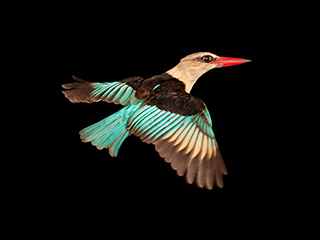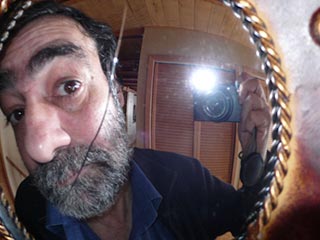Vanessa Alcaíno & Alejandro Malo
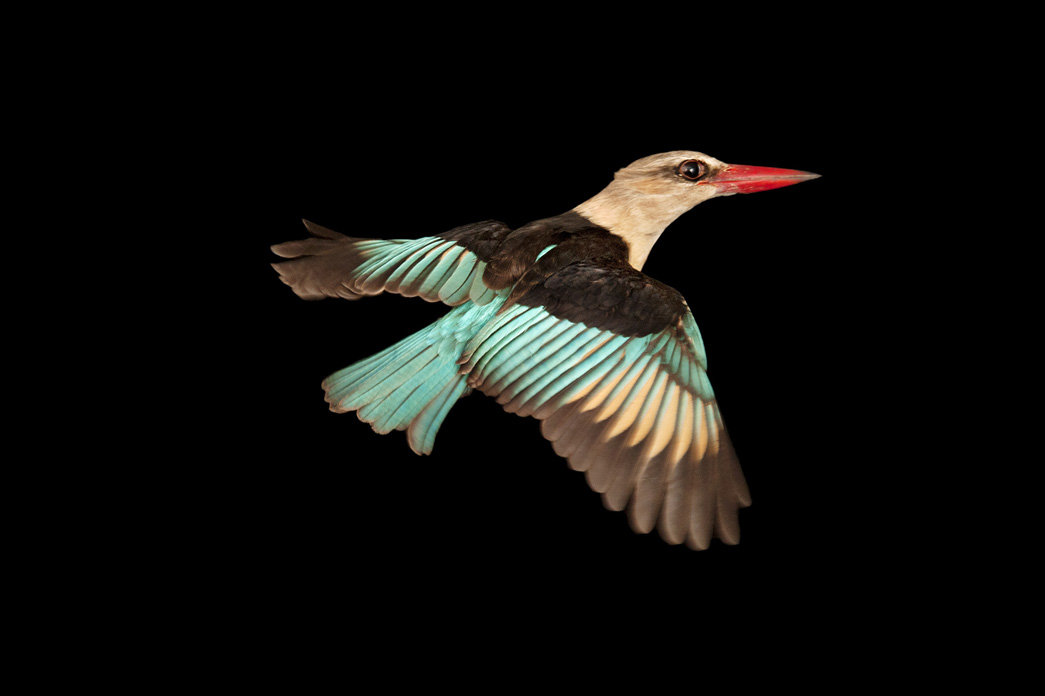
Brown Hooded Kingfisher, (Halcyon albiventris), Chitengo Camp, Gorongosa National Park, Mozambique, 2011. By Joel Sartore
When we choose to address a landscape issue and, soon after, we realized its relationship with the theme of the FotoFest 2016 Biennial: Changing Circumstances: Looking at the Future of the Planet, we thought it appropriate to echo the concerns expressed during the festival. A few contents presented in this issue offer a digital version of the same exhibitions for our audience. However, this observation would be insufficient without emphasizing some of the ideas included in the book of the same name that drives us to insist on the invitation to peer into its pages.
Conceived as a collaboration between Frederick Baldwin and Wendy Watriss, founders of FotoFest, with Steven Evans, Executive Director of the festival, it integrates a diverse and broad mosaic of artists. In his introductory text, Steven Evans highlights the need to promote the exchange of ideas between artists who use different strategies to address the issue. It also contrast the divergence of gazes with the unifying leitmotif of Thomas E. Lovejoy and Geof Rayner essays that show an intrinsic connection between all artist’s concerns. Both essays provide strong arguments on the urgent need for action on climate change; the first, from the perspective of the Earth as a living organism, and the second by demonstrating the decisive role of human beings in their environment.
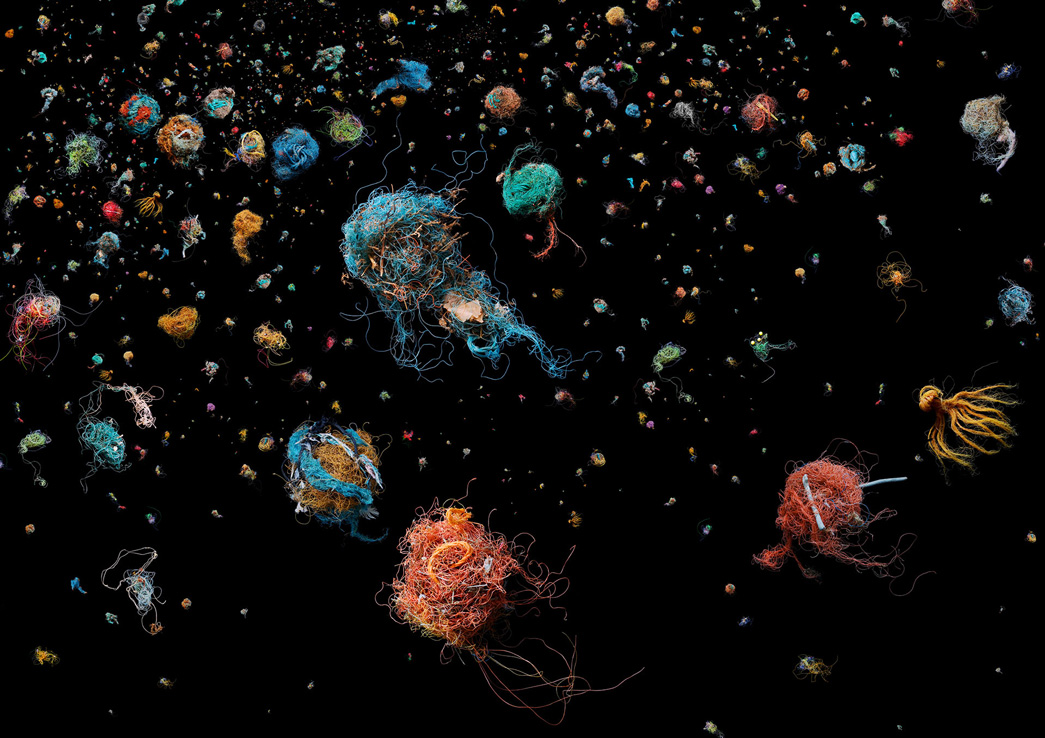
Bird’s Nest, 2011. Por Mandy Barker
Finally, Wendy Watriss gives voice to some questions that resonate with concerns we encountered during our research on the theme of landscape: "We have responsibility not only for our own well-being but that of the rest of the natural world? Can art stimulate new perspectives and new ways of seeing?” Photography has in its hands the potential to share with us realities that otherwise would be inaccessible. The images are not neutral, they feed imagination and foster reflections, being a very effective means to make any problem palpable, visible and close, to the point of being able to bring them into the political sphere and encourage agreements. We agree with Wendy’s view that art can itself stimulate and expand our world view and present innovative ways to address the issue of climate change. We should not allow ourselves to have skewed visions that only address and speak from a knowledge area or a region of the world. We must open to different cultures, include divergent views, draw new and different boundaries, create unique maps, put the world upside down, stir and divide it in various ways. That is the only way to visualize a future where rather than dominate nature, we can collaborate for its survival and ours. And this way of ‘seeing’ the world, and the new paths to our future, is what art may best express.
 Vanessa Alcaíno Pizani (Venezuela, 1980). Lives and works in Mexico. Visual artist. She graduated in Philosophy at the Central University of Venezuela and has a Master’s degree in Spanish and Latin American Thought at the Autonomous University of Madrid (UAM). Since 1994, she has worked in the field of photography at various institutions and organisations in Venezuela, Argentina and Mexico. At the moment, she is part of the editorial team of zonezero.com.
Vanessa Alcaíno Pizani (Venezuela, 1980). Lives and works in Mexico. Visual artist. She graduated in Philosophy at the Central University of Venezuela and has a Master’s degree in Spanish and Latin American Thought at the Autonomous University of Madrid (UAM). Since 1994, she has worked in the field of photography at various institutions and organisations in Venezuela, Argentina and Mexico. At the moment, she is part of the editorial team of zonezero.com. Alejandro Malo (Mexico, 1972). Lives and works in Mexico and is the director of ZoneZero. Since 1993, he has taken part in various cultural projects and worked as an information technology consultant. He has collaborated in print and electronic publications, and given workshops and conferences on literature, creative writing, storytelling and technology. In 2009, Malo joined the team of the Fundación Pedro Meyer, where he directs the Archives and Technology departments.
Alejandro Malo (Mexico, 1972). Lives and works in Mexico and is the director of ZoneZero. Since 1993, he has taken part in various cultural projects and worked as an information technology consultant. He has collaborated in print and electronic publications, and given workshops and conferences on literature, creative writing, storytelling and technology. In 2009, Malo joined the team of the Fundación Pedro Meyer, where he directs the Archives and Technology departments.
Brown Hooded Kingfisher, (Halcyon albiventris), Chitengo Camp, Gorongosa National Park, Mozambique, 2011. By Joel Sartore
When we choose to address a landscape issue and, soon after, we realized its relationship with the theme of the FotoFest 2016 Biennial: Changing Circumstances: Looking at the Future of the Planet, we thought it appropriate to echo the concerns expressed during the festival. A few contents presented in this issue offer a digital version of the same exhibitions for our audience. However, this observation would be insufficient without emphasizing some of the ideas included in the book of the same name that drives us to insist on the invitation to peer into its pages.
Conceived as a collaboration between Frederick Baldwin and Wendy Watriss, founders of FotoFest, with Steven Evans, Executive Director of the festival, it integrates a diverse and broad mosaic of artists. In his introductory text, Steven Evans highlights the need to promote the exchange of ideas between artists who use different strategies to address the issue. It also contrast the divergence of gazes with the unifying leitmotif of Thomas E. Lovejoy and Geof Rayner essays that show an intrinsic connection between all artist’s concerns. Both essays provide strong arguments on the urgent need for action on climate change; the first, from the perspective of the Earth as a living organism, and the second by demonstrating the decisive role of human beings in their environment.

Bird’s Nest, 2011. Por Mandy Barker
Finally, Wendy Watriss gives voice to some questions that resonate with concerns we encountered during our research on the theme of landscape: "We have responsibility not only for our own well-being but that of the rest of the natural world? Can art stimulate new perspectives and new ways of seeing?” Photography has in its hands the potential to share with us realities that otherwise would be inaccessible. The images are not neutral, they feed imagination and foster reflections, being a very effective means to make any problem palpable, visible and close, to the point of being able to bring them into the political sphere and encourage agreements. We agree with Wendy’s view that art can itself stimulate and expand our world view and present innovative ways to address the issue of climate change. We should not allow ourselves to have skewed visions that only address and speak from a knowledge area or a region of the world. We must open to different cultures, include divergent views, draw new and different boundaries, create unique maps, put the world upside down, stir and divide it in various ways. That is the only way to visualize a future where rather than dominate nature, we can collaborate for its survival and ours. And this way of ‘seeing’ the world, and the new paths to our future, is what art may best express.
 Vanessa Alcaíno Pizani (Venezuela, 1980). Lives and works in Mexico. Visual artist. She graduated in Philosophy at the Central University of Venezuela and has a Master’s degree in Spanish and Latin American Thought at the Autonomous University of Madrid (UAM). Since 1994, she has worked in the field of photography at various institutions and organisations in Venezuela, Argentina and Mexico. At the moment, she is part of the editorial team of zonezero.com.
Vanessa Alcaíno Pizani (Venezuela, 1980). Lives and works in Mexico. Visual artist. She graduated in Philosophy at the Central University of Venezuela and has a Master’s degree in Spanish and Latin American Thought at the Autonomous University of Madrid (UAM). Since 1994, she has worked in the field of photography at various institutions and organisations in Venezuela, Argentina and Mexico. At the moment, she is part of the editorial team of zonezero.com. Alejandro Malo (Mexico, 1972). Lives and works in Mexico and is the director of ZoneZero. Since 1993, he has taken part in various cultural projects and worked as an information technology consultant. He has collaborated in print and electronic publications, and given workshops and conferences on literature, creative writing, storytelling and technology. In 2009, Malo joined the team of the Fundación Pedro Meyer, where he directs the Archives and Technology departments.
Alejandro Malo (Mexico, 1972). Lives and works in Mexico and is the director of ZoneZero. Since 1993, he has taken part in various cultural projects and worked as an information technology consultant. He has collaborated in print and electronic publications, and given workshops and conferences on literature, creative writing, storytelling and technology. In 2009, Malo joined the team of the Fundación Pedro Meyer, where he directs the Archives and Technology departments.Vanessa Alcaíno & Elisa Rugo
That which I call my self-portrait is composed of thousands of days of work.
Each of them corresponds to the exact number and moment at which
I stopped as I painted after a task.
—Roman Opalka
Through the various forms of artistic expression over the last 500 years, the natural relationship born between the creator and his work tool has offered a rough testimony of self-exploration. We can see it from the self-portraits of Renaissance painters to the self-explorations produced by photographers opposite a mirror. The difference is that today we live in, thorough and for the image, and the image has driven us to communicate in a new way. Today, it has become a right to possess images of one’s self, and in this context the selfie appears to have emerged as a logical derivation of this human action.
Could we therefore consider selfies within the tradition of the self-portrait? Do they serve to search for, or develop, one’s identity? Let us begin with the idea that a selfie is not only a self-portrait in the traditional sense of the word. The selfie is created using a smart phone or webcam and places us in a spontaneous context or situation, showing its relative lack of preparation, but it also contains metadata that are commented on and shared repeatedly. This could define it as an emerging sub-genre of the self-portrait1, as taking this photographic image is in line with the new platforms of audiovisual communication.
However, the most appealing facet of this “new” trend is its social value. Current-day self-portraits do not seek to say this is me or this is how I am, as was done in times gone by to construct an identity, but rather they follow the logic of here I am or this is where I am. Being somewhere at a given moment prevails over just being. Persons therefore show themselves in a location, saying: this is where and how I am right now, with a mood: this is how I am today, or even, when in company: here I am with so-and-so. “Photography is not a memory, but an act”.2
The numerous self-portraits published every day construct visual diaries that show us multiple, plural and at the same time communal “private” stories. They are, in the digital era, the result of the democratization of the image, and acquire meaning once they are shared, not only among a specific group of persons (friends and/or relatives), but among all those who construct meaning through their interactions. The more active the exchange in networks, the stronger the links between their participants.
There are currently pages specializing in selfies that gather images in similar situations (selfiesatfunerals, selfieswithhomelesspeople, selfiesatseriousplaces, museumselfies.tumblr.com), projects that bring together collections of the (app.thefacesoffacebook, A través del espejo by Joan Fontcuberta), studies (selfiecity.net), new trends (Shaky Selfie), competitions, festivals (ClaroEcuador, Olimpiadas del selfie) and every day new apps appear that encourage us to tell a story by capturing images (Frontback). On many occasions film stars, musicians and celebrities such as the Pope or presidents express themselves through this medium, creating an intimate proximity with the public.
Taking photographs (of one’s self) has become an ordinary, everyday action. As Fontcuberta writes, it has become a compulsion. A vital compulsion in which each heartbeat becomes an image, such as the project The Whale Hunt, by Jonathan Harris, which uses 3,214 timed photographs to show in frequencies the most powerful moments of his experience of whale hunting. We are in an era that strives to photograph everything and create an interaction, in a context in which the photographic image has become a desire to speak. May nothing remain unrecorded or unshared! as we only exist insofar as we are present online.
What then of privacy? The intimate has become public. In 2000, a performance was presented called Nautilus, casa transparente.3 It consisted of a space with translucent walls in which a person was carrying out their daily life. People, some curious, others outraged, spend hours obsessively observing this person in his ordinary intimacy, as though he were an animal in a zoo. A few years later, and thanks to photography and its connectivity, we appear to be putting ourselves in this person’s place willingly and living in our own glass houses, exhibiting our everyday life without fear or prejudice.
Today’s democratized self-portrait is a public declaration carrying the message of our identity. The numerous devices and platforms used to communicate through the image enable us to react and create the need to leave a trace, in order for others to discover us. The selfie has become a social phenomenon of self-expression that can be as diverse as humanity itself, but we do not know to what extent social or cultural experiences are measured by the endless software. We are therefore invited to continue to take portraits of ourselves until technology becomes insufficient and we exceed the mobility, ubiquity and connection offered by the fifth moment of photography.4



























1 Tifentale, Alise. The Selfie: Making sense of the “Masturbation of Self-Image” and the “Virtual Mini-Me”. February 2014 / selfiecity.net
2 Fontcuberta, Joan. Quote from Joan Fontcuberta: el post-talento fotográfico. February 2014 by Galcerán de Born
3 Nautilus, casa transparente, an original idea by the Chilean architect Arturo Torres
4 The fifth momento of photography explores the effect of the iphone on photography, the technological 'mash-up' with the internet and omnipresent social connectivity. Edgar Gómez, and Eric T. Meyer. Creation and Control in the Photographic Process: iPhones and the Emerging Fifth Moment of Photography. Photographies 5, number 2 (2012): 203-221.
 Vanessa Alcaíno Pizani (Venezuela, 1980). Lives and works in Mexico. Visual artist. She graduated in Philosophy at the Central University of Venezuela and has a Master’s degree in Spanish and Latin American Thought at the Autonomous University of Madrid (UAM). Since 1994, she has worked in the field of photography at various institutions and organisations in Venezuela, Argentina and Mexico. At the moment, she is part of the editorial team of zonezero.com. You can see her work at: vanessapizani
Vanessa Alcaíno Pizani (Venezuela, 1980). Lives and works in Mexico. Visual artist. She graduated in Philosophy at the Central University of Venezuela and has a Master’s degree in Spanish and Latin American Thought at the Autonomous University of Madrid (UAM). Since 1994, she has worked in the field of photography at various institutions and organisations in Venezuela, Argentina and Mexico. At the moment, she is part of the editorial team of zonezero.com. You can see her work at: vanessapizani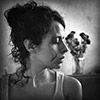 Elisa Rugo (Mexico, 1980). Lives and works in Mexico. She is a photographer, videographer and a specialist in visual communication with a degree in Creative Visualisation at the University of Communication. In 2012, she took part in the seminar Contemporary Photography at the Image Centre. She has participated in collective exhibitions in Pachuca, Querétaro, Guadalajara and Mexico-City. At the moment, she is the art director of the websites fpmeyer.com and museodemujeres.com and she is part of the editorial team of zonezero.com. You can see her work at: elisarugo.pro
Elisa Rugo (Mexico, 1980). Lives and works in Mexico. She is a photographer, videographer and a specialist in visual communication with a degree in Creative Visualisation at the University of Communication. In 2012, she took part in the seminar Contemporary Photography at the Image Centre. She has participated in collective exhibitions in Pachuca, Querétaro, Guadalajara and Mexico-City. At the moment, she is the art director of the websites fpmeyer.com and museodemujeres.com and she is part of the editorial team of zonezero.com. You can see her work at: elisarugo.proThat which I call my self-portrait is composed of thousands of days of work.
Each of them corresponds to the exact number and moment at which
I stopped as I painted after a task.
—Roman Opalka
Through the various forms of artistic expression over the last 500 years, the natural relationship born between the creator and his work tool has offered a rough testimony of self-exploration. We can see it from the self-portraits of Renaissance painters to the self-explorations produced by photographers opposite a mirror. The difference is that today we live in, thorough and for the image, and the image has driven us to communicate in a new way. Today, it has become a right to possess images of one’s self, and in this context the selfie appears to have emerged as a logical derivation of this human action.
Could we therefore consider selfies within the tradition of the self-portrait? Do they serve to search for, or develop, one’s identity? Let us begin with the idea that a selfie is not only a self-portrait in the traditional sense of the word. The selfie is created using a smart phone or webcam and places us in a spontaneous context or situation, showing its relative lack of preparation, but it also contains metadata that are commented on and shared repeatedly. This could define it as an emerging sub-genre of the self-portrait1, as taking this photographic image is in line with the new platforms of audiovisual communication.
However, the most appealing facet of this “new” trend is its social value. Current-day self-portraits do not seek to say this is me or this is how I am, as was done in times gone by to construct an identity, but rather they follow the logic of here I am or this is where I am. Being somewhere at a given moment prevails over just being. Persons therefore show themselves in a location, saying: this is where and how I am right now, with a mood: this is how I am today, or even, when in company: here I am with so-and-so. “Photography is not a memory, but an act”.2
The numerous self-portraits published every day construct visual diaries that show us multiple, plural and at the same time communal “private” stories. They are, in the digital era, the result of the democratization of the image, and acquire meaning once they are shared, not only among a specific group of persons (friends and/or relatives), but among all those who construct meaning through their interactions. The more active the exchange in networks, the stronger the links between their participants.
There are currently pages specializing in selfies that gather images in similar situations (selfiesatfunerals, selfieswithhomelesspeople, selfiesatseriousplaces, museumselfies.tumblr.com), projects that bring together collections of the (app.thefacesoffacebook, A través del espejo by Joan Fontcuberta), studies (selfiecity.net), new trends (Shaky Selfie), competitions, festivals (ClaroEcuador, Olimpiadas del selfie) and every day new apps appear that encourage us to tell a story by capturing images (Frontback). On many occasions film stars, musicians and celebrities such as the Pope or presidents express themselves through this medium, creating an intimate proximity with the public.
Taking photographs (of one’s self) has become an ordinary, everyday action. As Fontcuberta writes, it has become a compulsion. A vital compulsion in which each heartbeat becomes an image, such as the project The Whale Hunt, by Jonathan Harris, which uses 3,214 timed photographs to show in frequencies the most powerful moments of his experience of whale hunting. We are in an era that strives to photograph everything and create an interaction, in a context in which the photographic image has become a desire to speak. May nothing remain unrecorded or unshared! as we only exist insofar as we are present online.
What then of privacy? The intimate has become public. In 2000, a performance was presented called Nautilus, casa transparente.3 It consisted of a space with translucent walls in which a person was carrying out their daily life. People, some curious, others outraged, spend hours obsessively observing this person in his ordinary intimacy, as though he were an animal in a zoo. A few years later, and thanks to photography and its connectivity, we appear to be putting ourselves in this person’s place willingly and living in our own glass houses, exhibiting our everyday life without fear or prejudice.
Today’s democratized self-portrait is a public declaration carrying the message of our identity. The numerous devices and platforms used to communicate through the image enable us to react and create the need to leave a trace, in order for others to discover us. The selfie has become a social phenomenon of self-expression that can be as diverse as humanity itself, but we do not know to what extent social or cultural experiences are measured by the endless software. We are therefore invited to continue to take portraits of ourselves until technology becomes insufficient and we exceed the mobility, ubiquity and connection offered by the fifth moment of photography.4



























1 Tifentale, Alise. The Selfie: Making sense of the “Masturbation of Self-Image” and the “Virtual Mini-Me”. February 2014 / selfiecity.net
2 Fontcuberta, Joan. Quote from Joan Fontcuberta: el post-talento fotográfico. February 2014 by Galcerán de Born
3 Nautilus, casa transparente, an original idea by the Chilean architect Arturo Torres
4 The fifth momento of photography explores the effect of the iphone on photography, the technological 'mash-up' with the internet and omnipresent social connectivity. Edgar Gómez, and Eric T. Meyer. Creation and Control in the Photographic Process: iPhones and the Emerging Fifth Moment of Photography. Photographies 5, number 2 (2012): 203-221.
 Vanessa Alcaíno Pizani (Venezuela, 1980). Lives and works in Mexico. Visual artist. She graduated in Philosophy at the Central University of Venezuela and has a Master’s degree in Spanish and Latin American Thought at the Autonomous University of Madrid (UAM). Since 1994, she has worked in the field of photography at various institutions and organisations in Venezuela, Argentina and Mexico. At the moment, she is part of the editorial team of zonezero.com. You can see her work at: vanessapizani
Vanessa Alcaíno Pizani (Venezuela, 1980). Lives and works in Mexico. Visual artist. She graduated in Philosophy at the Central University of Venezuela and has a Master’s degree in Spanish and Latin American Thought at the Autonomous University of Madrid (UAM). Since 1994, she has worked in the field of photography at various institutions and organisations in Venezuela, Argentina and Mexico. At the moment, she is part of the editorial team of zonezero.com. You can see her work at: vanessapizani Elisa Rugo (Mexico, 1980). Lives and works in Mexico. She is a photographer, videographer and a specialist in visual communication with a degree in Creative Visualisation at the University of Communication. In 2012, she took part in the seminar Contemporary Photography at the Image Centre. She has participated in collective exhibitions in Pachuca, Querétaro, Guadalajara and Mexico-City. At the moment, she is the art director of the websites fpmeyer.com and museodemujeres.com and she is part of the editorial team of zonezero.com. You can see her work at: elisarugo.pro
Elisa Rugo (Mexico, 1980). Lives and works in Mexico. She is a photographer, videographer and a specialist in visual communication with a degree in Creative Visualisation at the University of Communication. In 2012, she took part in the seminar Contemporary Photography at the Image Centre. She has participated in collective exhibitions in Pachuca, Querétaro, Guadalajara and Mexico-City. At the moment, she is the art director of the websites fpmeyer.com and museodemujeres.com and she is part of the editorial team of zonezero.com. You can see her work at: elisarugo.pro

